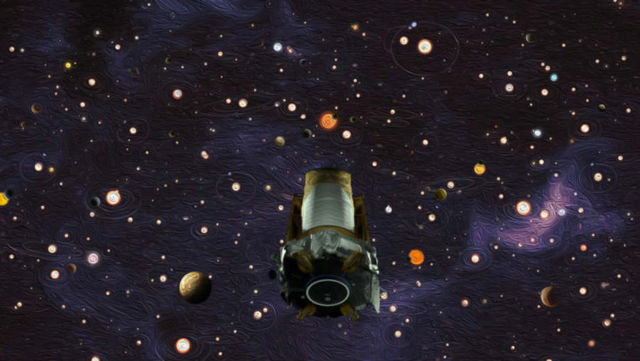New study provides most accurate estimate of frequency that exoplanets similar to Earth occur around stars similar to our sun.
A new study by researchers at Penn State and Brigham Young University provides the most accurate estimate of the frequency that planets that are similar to Earth in size and in distance from their host star occur around stars similar to our sun. Knowing the rate that these potentially habitable planets occur will be important for designing future astronomical missions to characterize nearby rocky planets around sun-like stars that could support life.
Above, artist’s impression of NASA’s Kepler space telescope, which discovered thousands of new planets. New research, using Kepler data, provides the most accurate estimate to date of how often we should expect to find Earth-like planets near sun-like stars. Image: NASA/Ames Research Center/W. Stenzel/D. Rutter
Thousands of planets have been discovered by NASA’s Kepler space telescope. Kepler, which was launched in 2009 and retired by NASA in 2018 when it exhausted its fuel supply, observed hundreds of thousands of stars and identified planets outside of our solar system — exoplanets — by documenting transit events. Transits events occur when a planet’s orbit passes between its star and the telescope, blocking some of the star’s light so that it appears to dim. By measuring the amount of dimming and the duration between transits and using information about the star’s properties, astronomers characterize the size of the planet and the distance between the planet and its host star.
“Kepler discovered planets with a wide variety of sizes, compositions and orbits,” said Eric B. Ford, professor of astronomy and astrophysics at Penn State and one of the leaders of the research team. “We want to use those discoveries to improve our understanding of planet formation and to plan future missions to search for planets that might be habitable. However, simply counting exoplanets of a given size or orbital distance is misleading, since it’s much harder to find small planets far from their star than to find large planets close to their star.”
To overcome that hurdle, the researchers designed a new method to infer the occurrence rate of planets across a wide range of sizes and orbital distances. The new model simulates “universes” of stars and planets and then “observes” these simulated universes to determine how many of the planets would have been discovered by Kepler in each “universe.”
“We used the final catalog of planets identified by Kepler and improved star properties from the European Space Agency’s Gaia spacecraft to build our simulations,” said Danley Hsu, a graduate student at Penn State and the first author of the paper. “By comparing the results to the planets cataloged by Kepler, we characterized the rate of planets per star and how that depends on planet size and orbital distance. Our novel approach allowed the team to account for several effects that have not been included in previous studies.”
A paper describing the model appears in The Astronomical Journal.
source Penn State






Leave A Comment